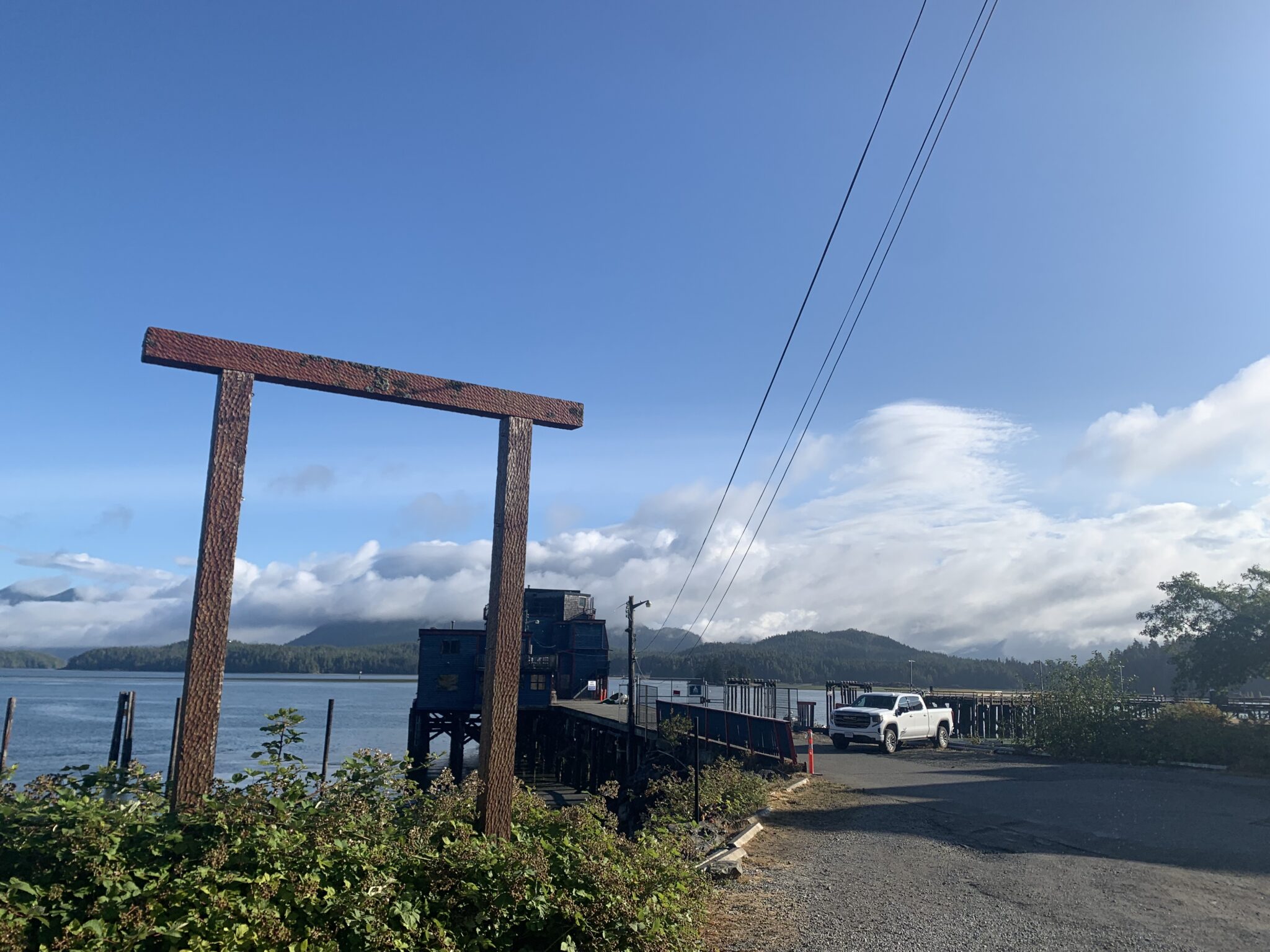Happy New Year – I say in March …
Much to hope for this year, and much to reflect on. Currently, I am planning for where and what I will be doing this year. Both professionally and personally, I am pensive as ever about what travel looks like nowadays.
2023 was not cake walk, and I suspect 2024 will not be either. So, what do you do then, when you sense an obligation to be prepared and planned?
Well, I think it starts with reevaluation of expectations. In terms of this blog Expat-terns, we can think about what that means here:
Expat-terns & Expectations
Let’s talk post regularity. Expat-terns has been a blog since, I believe, 2013, which means we are over a decade old.
That is not a small feat. I remember beginning writing this blog when I was living in Chile. It has been and still is an important medium for my attestation and reflection.
With a full-time job, small weenie dog, and other of life’s obligations, scheduled posts have definitely fallen by the wayside. It is also important to acknowledge that the world of blogging (especially travel blogging) has changed dramatically since the 2010s.
What does this all mean for Expat-terns and its continuity?
Well, Expat-terns will continue. That is for sure. However, posts will be asynchronous a bit. I used to plan and try to align posts to publish right around or after the completion of a trip. These expedited timelines are not realistic nowadays and lend to worse quality and substance of writing.
For example, the next two posts (including this one) that I will publish involve experiences from summer and fall 2023. These both will be shared no sooner than late January 2024.
In short, I will have be better at taking notes on the road. I will need reflect more to highlight the most salient aspects I will want to share in posts. I think this regularity is most sustainable, which leads me to say, “keep with it,” to myself and you too.
Expat-terns has been rare to monetise or advertise, so it has remained a foremost personal venture. It makes sense then that, like myself, it takes a new shape in its age now. Something maturer, something more methodical.
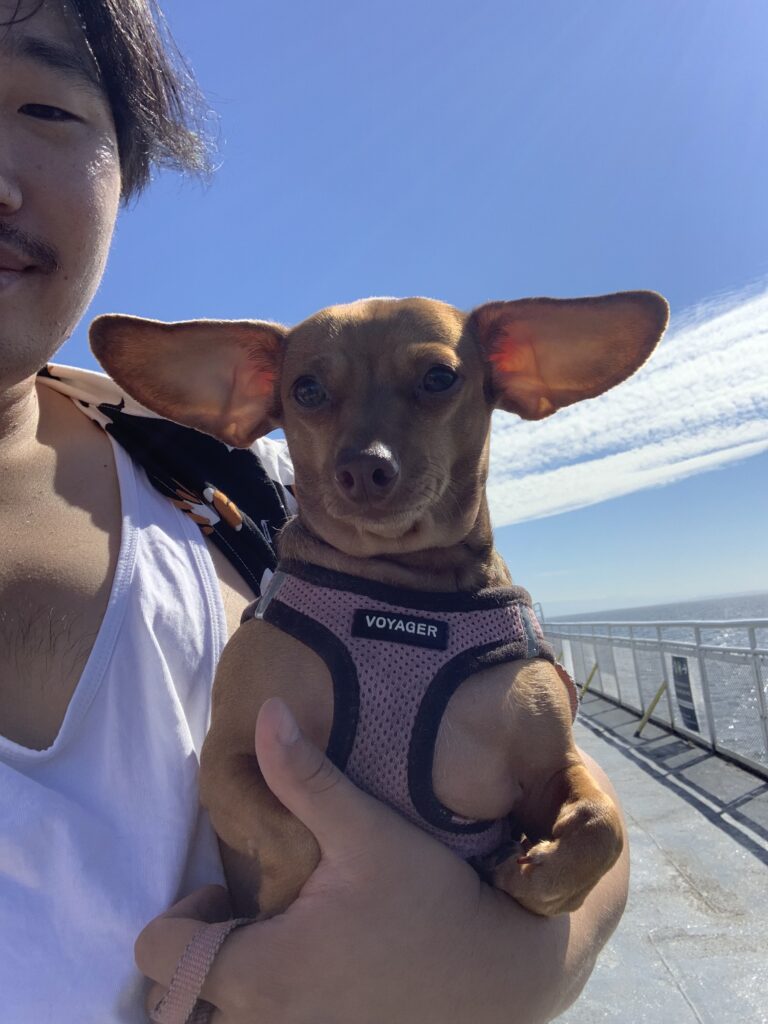
So, on that note, let’s talk the west coast of Vancouver Island!
July 2023, I was tasked with an exciting work trip to Tofino on the west coast of Vancouver Island. Despite the location and season being rather perfect, it was not necessarily an easy road trip for myself. Let’s get into it:
Territories You Pass Through
I try to remain conscious of the territories I pass through whenever I travel. It is something I recommend to you as you traverse regions yourself, especially Vancouver Island.
As an island with rich resources and varied topography, this area boasts a huge, dense amount of Indigenous diversity. This density & diversity mean also a complex social and political network of peoples. Depending on your departure point, you will pass through different Nations and their neighbours, which may be related or not.
We will start from coming up from the south:
Coast Salish
If coming up from Victoria, the province’s capital, one may pass through W̱SÁNEĆ, Malchosen, Songhees (Lək̓ʷəŋən), Semiahmoo, T’sou-ke, and territories. While distinct in name and identity, these Nations are relatives to one another. They share histories and a mutually intelligible language, sometimes referred to as North Straits Salish.
However, each community has a different name for their language, SENĆOŦEN / Malchosen / Lekwungen / Semiahmoo / T’Sou-ke. Their relations extend across the contemporary Canada-US border into what is now Washington, including the Samish and Lummi communities.
Up the Malahat Drive
You will encounter even more diversity and history on your route along the Malahat (Highway 1).
On your drive up, once you begin to enter Cowichan, you will cross into Hul̓q̓umín̓um̓-speaking peoples territory. While also a Coast Salish peoples culturally, the Hul̓q̓umín̓um̓-speaking speoples are diverse in political identity and community. For example, their language (related to mainland varieties of Halkomelem) is written in various orthographies or alphabet systems.

If you come in from the Mainland via BC Ferries, you will arrive in Snuneymuxw territory. The contemporary city ‘Nanaimo’ derives its name from this Nation. Stick around for the chocolatey, coconutty Nanaimo Bars or continue the drive north. You will then make it to your next junction and territorial passage.
While still in Coast Salish territory, as you head north of Nanaimo, the area increases multilingually. Recently reawakening through the collective efforts of the Qualicum First Nation, pentl’ach is another Coast Salish language that calls this stretch its home.
The work that the Nation is undertaking is truly transformative. It has gone on to impact even governmental legislation. Today, pentl’ach is now recognised as the 35th BC First Nations language, Indigenous to the province.
Looking to fill up before heading up island? I remember stopping at the Snaw-Naw-As station, conveniently located on the right lane to Parksville. The gas station is owned and operated by Snaw-Naw-As or Nanoose First Nation. For those who qualify, you can get Status Card tax exemptions on their petrol. In general, the prices are usually lower than other stations along the route.
Once passed Parksville, to get to Tofino, you will head west. As you turn, you also roughly skim Éy7á7juuthem-speaking territory: another Coast Salish language with a distinct people.
Nuu-chah-nulth
Heading west, this direction takes you into Nuu-chah-nulth or Nuučaan̓ułʔatḥ territory. The Nuučaan̓ułʔatḥ comprise fifteen different distinct entities with thirteen under an organizing Tribal Council. Historically, these peoples have also been referred to as ‘Nootka’ in anthropological literature. This name is considered very offensive today to use. It actually refers to a word in the nuučaan̓uɫ language: “circle around”.
The Nuučaan̓ułʔatḥ were one of the first peoples on what is now Vancouver Island to encounter European settlers/sailors. This name, or misinterpretation of directions, stuck from an initial encounter with Captain James Cook in the late 1700s.
Use Nuu-chah-nulth or Nuučaan̓ułʔatḥ today or name the respective First Nation in reference to its people, land, and waters. Check out this map, which gives a pretty good snapshot of the territorial distribution of the Nuučaan̓ułʔatḥ: link.
Fun fact: the oldest First Nations’ newspaper in Canada is also Nuu-chah-nulth run. It features important local, regional, and global news as relevant to these communities: Ha-Shilth-Sa.
The Way (HWY 4)
The main road to get to Tofino or Ucuclulet is Highway 4 (HWY 4) or Alberni Highway/Pacific Rim Highway. In fact, this route is essentially the only way to drive to the west coast of the island. There are smaller logging roads, but these are for experienced or local drivers who know them.
They also significantly extend one’s trip. It is possible to normally make it from Tofino to Vancouver or Victoria in a day by car. It is one hell of a schlepp, but it is possible.
Unfortunately, my tale of getting to Tofino last July 2023 was forever influenced by the periodic closure of HWY 4. Due to the increase of wildfires in areas previously uncommon, the passage between Coombs and Port Alberni was heavily impacted. Destabilisation of the rocky cliffsides that hug the highway meant the danger of rockslides!

Maintenance was undertaken during peak travel and tourist times, which made huge news in the province. Tofino is a tourist town, and many economies rely on the influx of visitors. With the road closing and only letting drivers through in small windows, transit was difficult and had to be precisely timed.
And yours truly, for a work trip, also was subject to this wonderful setback. I hope your trip out west on Vancouver Island is not the same in this respect. However, I do hope you take some of these insights and suggestions as you traverse HWY 4 like I did!
Major Stops
Many will reminisce of the stunning backdrops a road trip to Tofino will provide you. Vancouver Island possesses a diverse geography and topography with dense old-growth forests, steep crags, and tucked away lakes and ponds.
As you head out west, the climate remains consistent. Temperatures remain high in Port Alberni and Tofino during the summer months. Most residential architecture in British Columbia does not feature air conditioning. Keep that in mind when booking local accommodations and other rentals on your trip.
Coombs
The first landmarks you will pass along your route are in Coombs. It precedes Cameron Lake (where a lot of highway modifications take place). Coombs is known as a small town with a little less than 2000 people living their year round.
Its main attraction is undoubtedly the Old Country Market that is famously known for its green roof. Green as in grass, and grass as is domesticated goats are known to graze on top of it! The shop has groceries, some crafts, and other chachkies. But, the people come for the goats.
Aside from the store, there is really not much else in Coombs for passersby to try. However, if you are looking for a pitstop, there is a Thai restaurant that you can try: Thai Smile.
Why a Thai restaurant in Coombs, BC?
Well, it is hard to say. All along Vancouver Island (and elsewhere in rural BC), you will find one or two local restaurants run by immigrants who settled in the area and found a niche that the public loves. Think back to Bella Coola, where my countrymen also operate the hotel & restaurant …
My hunch is that Thai Smile falls into this category of locales. This alone makes it an establishment worth supporting and truly a gem of the region.
As you pass through Coombs, your next landmark is Cameron Lake. This lake indicates that you are only a few minutes at top speed to Port Alberni or c̓uumaʕas.
Port Alberni
Hugged by the Alberni Inlet, Port Alberni or c̓uumaʕas is the last major city before the next leg of the journey to the Pacific coast. The territory is traditional to the Tseshaht c̓išaaʔatḥ and Hupacasath Hupač̓asatḥ Nations: both Nuu-chah-nulth communities.
The city also trails along the Somass (the anglicized name, c̓uumaʕas) river, which translates to ‘washing’ in Nuu-chah-nulth.
While you could continue driving, there are many localities to enjoy in Port Alberni for a day or extended weekend.
Sights to See!
Like many smaller cities in BC, there is usually the one™ Chinese restaurant that locals swear by. In this case, Port Alberni boasts the Beijing Grand Restaurant, which is top notch. I have been told there is also a fierce rivalry between this establishment and another local Chinese eatery, Wait You Chinese Restaurant. I myself can only vouch for Beijing Grand, which has been recommended to me by many locals.
For something more to wet your whistle, Port Alberni also has a burgeoning local brewing scene.
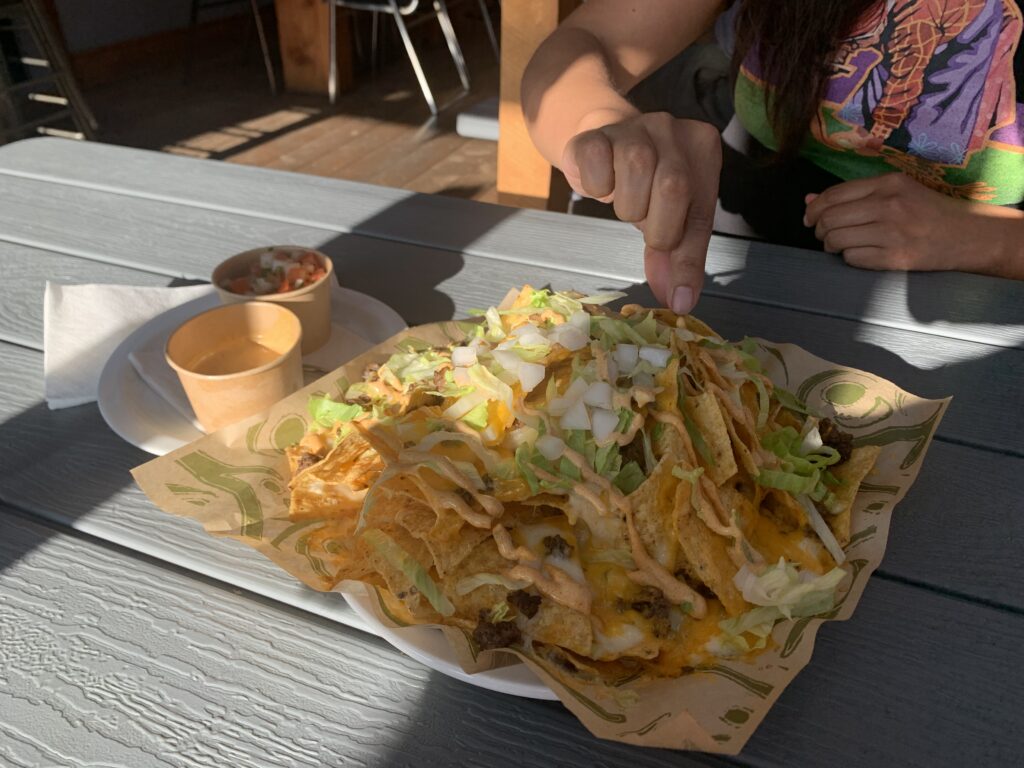
Twin City & Alberni Brewing are well known, as well as Dog Mountain Brewing, which I recommend.
Dog Mountain Brewing has a wonderful rooftop patio that is dog-friendly – yippee! It makes for a wonderful summer spot with a view of the water. A coworker and I went here with Sundae to watch a comedy show and enjoy a bit of sunshine after a successful day of long meetings.
The area does get steamy in the summer, so the waterside Quay and various shaded hiking trails are great ways to enjoy the natural beauty of the area and stay cool. I was lucky enough to see a bear while hiking at Stamp River Park. This easy hike also features salmon infographics, runs, waterfalls, and the occasional nude hippy swimmer.
Like in many locations across the coast, salmon is a central foodstuff you will see encounter. Port Alberni hosts a salmon fishing festival and derby in early September. It is sometimes referred to as the salmon capital of the world.
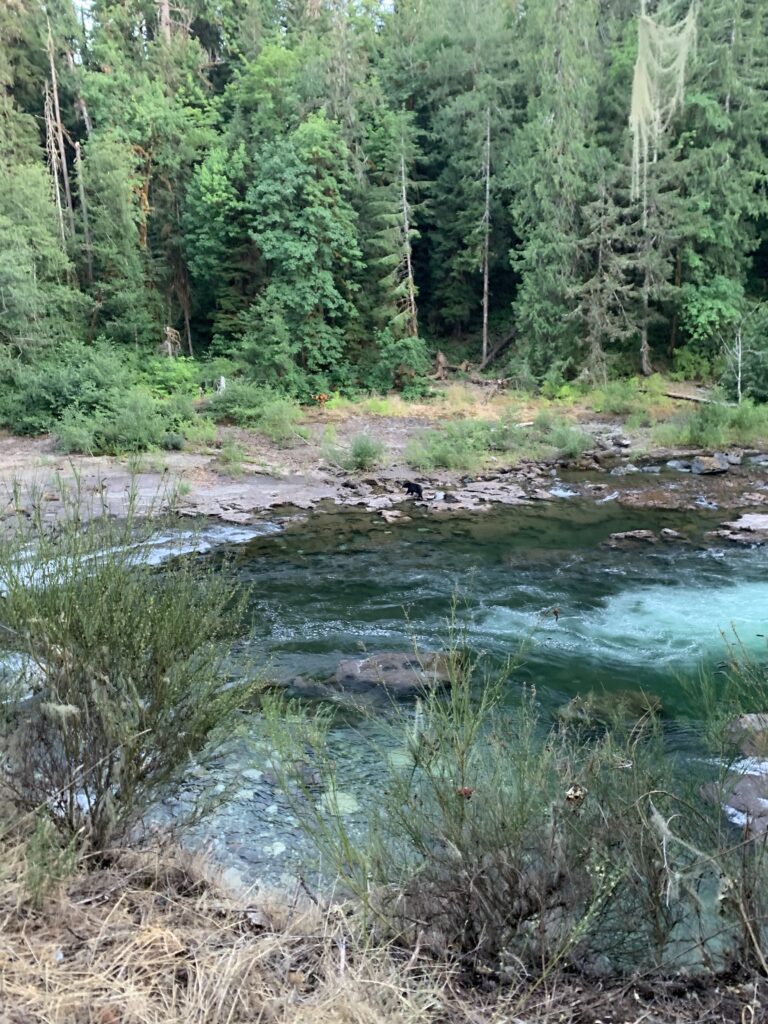
During the mid to late summer, you will likely see folks under pop-up tents selling sockeye along the road. Feel free to stop and purchase if you are so inclined!
Situate Yourself
As mentioned, the area is Nuu-chah-nulth. Port Alberni is also the home of the Nuu-chah-nulth Tribal Council (NTC). The council is not a tourist destination, but it is important to recognize with the Nations that call this region home. NTC delivers programs to Nuu-chah-nulth people and politically advocates for the 14 nations it represents.

A spot you should definitely stop off at is the Tseshaht Market. This pitstop is last full-service Gas Station between Port Alberni and Ucluelet & Tofino. It is a bit of a destination with food, great service, and a garden area to enjoy. You can also get tax-exempt gas here with a Status card!
Tofino & Ucluelet
Getting to Tofino from Port Alberni is for the most part straightforward. You continue to head west, and once you start to see Kennedy Lake (a massive body of water that resembles a small sea), you are getting close.
The final stretch of the trek is hilly and craggy with many twists and turns. Locals lament the slow drivers who take their time along the bends. If you see someone pulling up behind you, pull over and let them pass.
Once you descend from the hills and reach the seaside, there will be a fork in the road. The right will take you to Tofino while the left path will take you to Ucluelet, charmingly referred to as Ukee (yoo-kee) (IPA: /ˈju.ki/). The name Ucluelet comes from the local Nation: Yuułuʔiłʔatḥ.
Ucluelet is a smaller hamlet compared to Tofino and less touristy with a wonderful aquarium. It is a calmer destination compared to Tofino and a nice alternative to its Vancouver Island surfing capital sister.
On my next trip, I will definitely spend a day or two in this quieter west coast option.
Destination: Tofino
I was coming to Tofino or Tla-o-qui-aht territory for work with some meetings with local organizations. I also have a good friend who is Tla-o-qui-aht and often dogsits for me when I have other work trips. It worked out that I could bring along the pooch and stay with her locally.
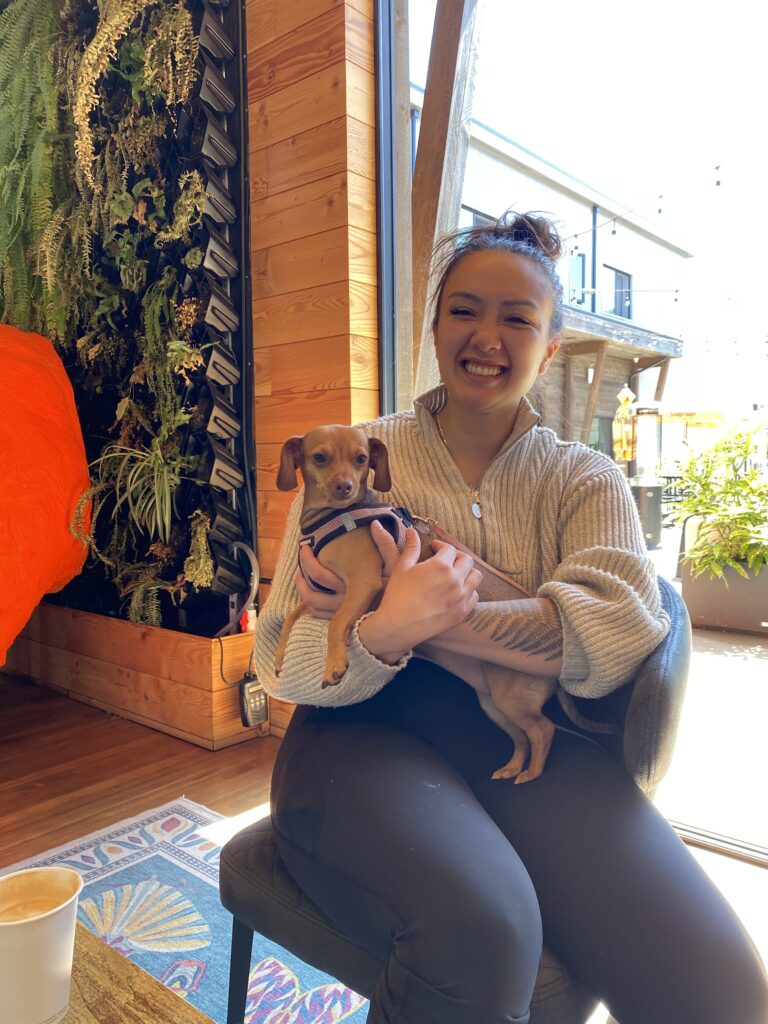
Through conversations with my friend, I came to Tofino already aware of some of the demographic dynamics. Firstly, the summers are busy! Even with the road closures at the time, Tofino with its shops and restaurants was booming with tourists.
The population fluctuates heavily depending on the season. There are many temporary workers from mainly Germany and Australia. They take up summer jobs in town and enjoy the beaches on their leisure time.
The saturation of foreigners gives you a bit of culture shock. Where are you? The west coast of Vancouver Island? In a sort of, tropical, beach town?
An unfortunate reality that occurs is the Indigenous history and presence of the territory can feel like they fade away into touristic aesthetics. In reality, while you may see many Help Wanted signs during the peak seasons, it is rare for local Tla-o-qui-aht folks to hold jobs in the main district of town. Some call the city itself divided in who enjoys and benefits from the tourist economy. Many business owners are transplants from other areas of Canada or international owners.
In this respect, I would implore visitors to Tofino to take it upon themselves to be good visitors and take the time to learn about the history of the region and respect its people:
- Learn about many of the local names that come from Tla-o-qui-aht figures or Nuu-chah-nulth language like MAQ from Chief Maquinna or Wickaninnish Inn, named after another prominent chief
- Do not park in the Tla-o-qui-aht resident parking spots around town for any reason – not for a quick 5-minutes, for a short lunch (just don’t!)
- Patron verifiable Tla-o-qui-aht businesses or recommended establishments
- Refrain from wandering onto or driving through the clearly marked reserve lands – this one is a big one!

During the onset of the COVID-19 pandemic, First Nations communities were on high alert. Many went into lockdowns, establishing checkpoints. In Tofino, due to their proximity to the high-density, non-local population, communities made their entrances easily identifiable with signage to indicate that only residents were welcome for safety reasons.
Communities had always been clear that they did not want trespassers or tourists wandering in. However, since the height of the COVID-19 pandemic, the signs have stayed up. One disturbing trend has been that visitors to Tofino wanted to intrude and tour the reserves. Indigenous communities, especially people’s residences, are not tourist attractions. At bare minimum, it is a courtesy to avoid trespassing.
As visitors to the territory (including its tribal parks), you can read up and take the ʔiisaak Pledge in recognition and support of the stewardship of these lands and waters.
What to Do
Beach vibes and good food are Tofino’s mainstays for visitors and locals alike.

The most popular beaches are Long Beach, Cox Bay, MacKenzie, Third, and probably Chesterman. These spots are heavily frequented by tourists in the summer. Parking can be a bit tricky, but some locations are punitive if you do not pay.

However, if there is one with a clearly marked pay station, you may be fined. I did not have any trouble parking at MacKenzie with Sundae and skirting any tickets.
These beaches are of course good for sunbathing, lounging, and surfing. Hitting the waves is easy with rentals and lessons available from a plethora of local businesses.

Dogs are welcome on Tofino beaches, which is a wonderful change of pace. As long as you pick up after them, dogs can join you for a little sun and surf. In general, restaurants and cafés are much less strict about having pooches with you compared to Victoria, Nanaimo, and Vancouver.
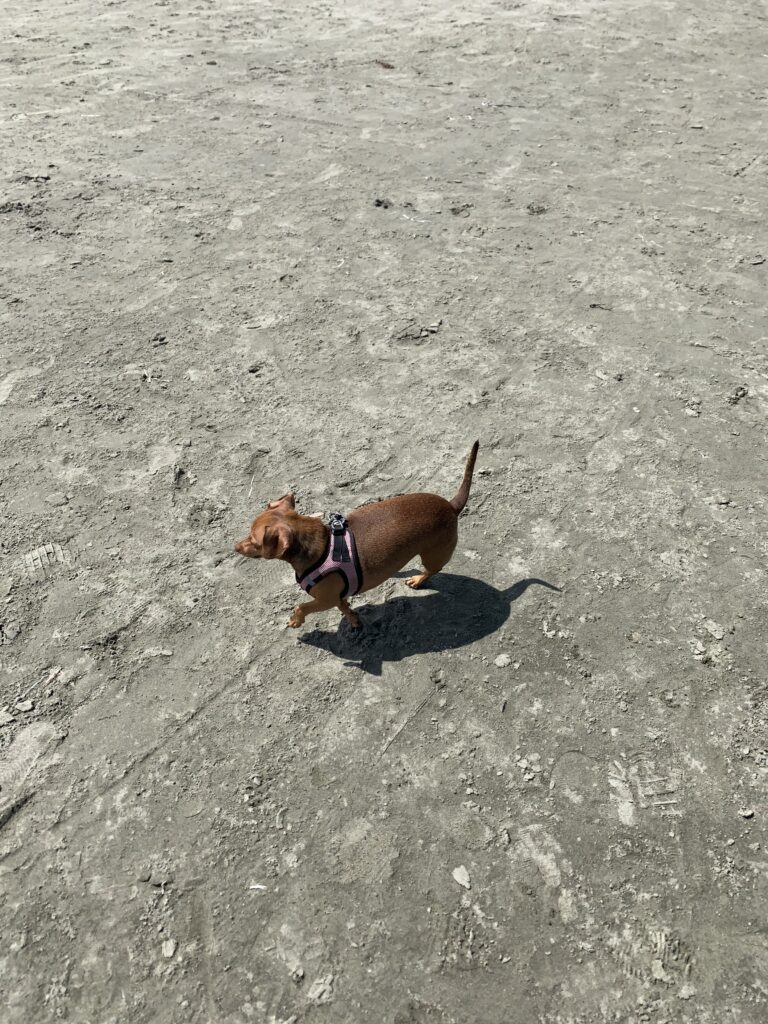
For an evening out, Tofino Brewing Company is a local staple with a huge selections of beers and other alcoholic choices. It gets busy in the evenings. However, there is usually a quick enough pace of people coming in and out to find a free seat.

For a true dining experience, Shelter and Wolf in the Fog are acclaimed choices that offer nouveau Canadian fare. One locale I wanted to try but did not get around to is Jeju: a Korean restaurant. I will sample the food of my countrymen next time, for sure.
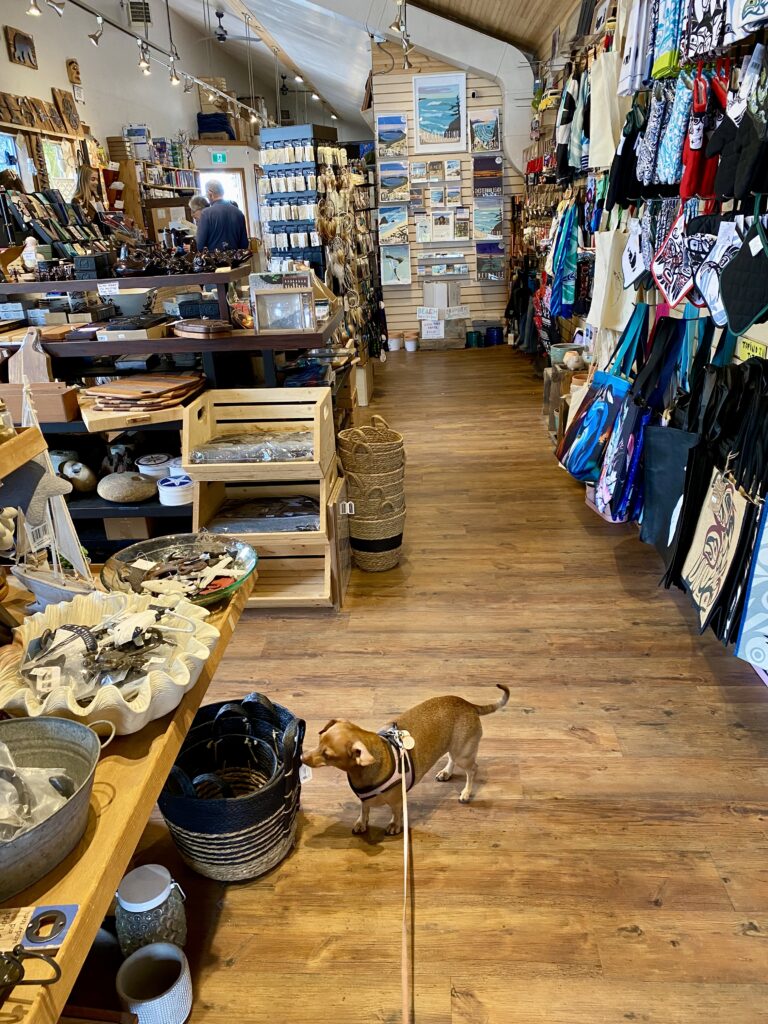
There are many an option for excursions and activities to do in town or in the surrounding territory. A very large, prominent destination for tourists is the Roy Henry Vickers Gallery. This gallery space resembles a big house and is based centrally in town.
While the art here is authentic First Nations, the principal artist is admittedly not Tla-o-qui-aht (or Nuu-chah-nulth), but Tsimshian, Haida, and Heiltsuk.
For Tla-o-qui-aht or Ahousaht (a neighbouring Nuu-chah-nulth Nation) affiliated businesses, you can also consider patronising Naas Foods (seafood shop), Clayoquot Wild tours (nature & whale tours/charters), and the House of Himwitsa (gallery & shop).
Full disclosure: I have worked with the owner of this charter; people wear many hats!
If you are looking for more activities and businesses to frequent, consider the Allies to the Tla-o-qui-aht Tribal Parks. These organizations have agreed to provide a 1% Ecosystem Service fee to support the Tribal Parks Guardian Stewardship program.
Where to Stay
There is a variety of accommodations from which to choose in Tofino for your stay. Many of these options are also allies to the Tribal Parks Guardian program.
One of most direct ways to show support is to stay at the Tin Wis Hotel, which owned by the Tla-o-qui-aht Nation. It features beachfront accommodations for visitors and other great amenities.
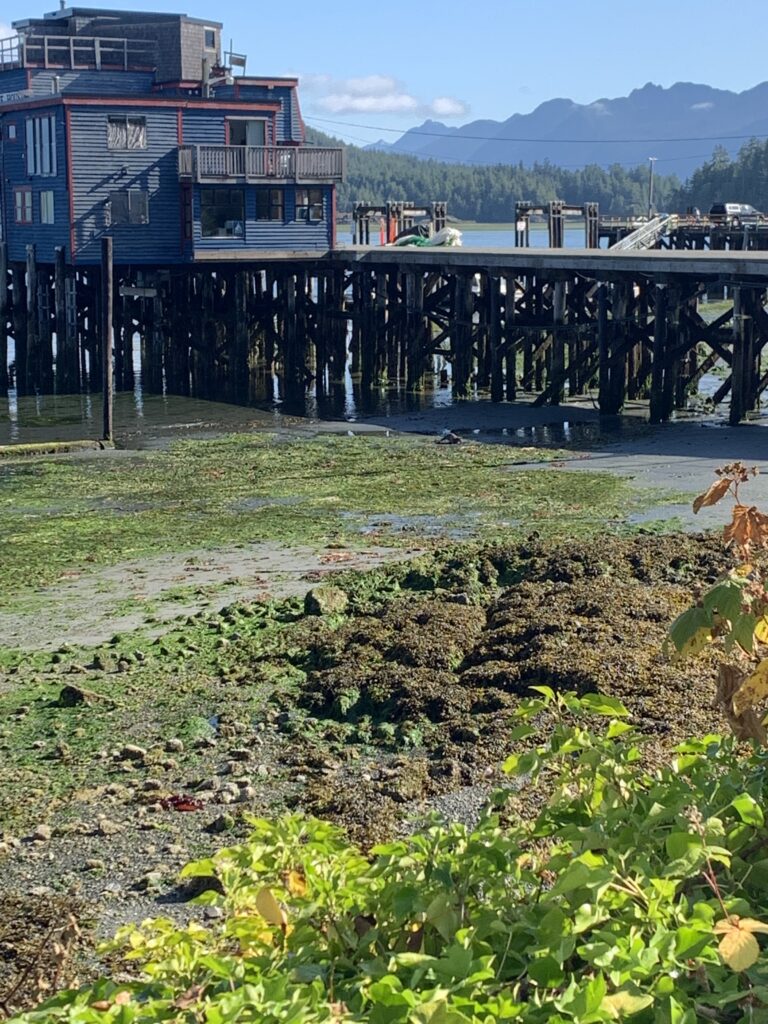
One of the most funky is Hotel Zed. Outside of town, Hotel Zed is a local chain with this colourful, retro vibe that attracts families and younger people to its brand. My colleague stayed her during our short stay, and I came to the hotel to meet up with her. The hotel is dog-friendly, and staff is nice and nonplussed by individuals just hanging about (e.g., me and Sundae).
Locations In Town
That is sort of the vibe and character of Tofino to be frank. The MAQ is similar in that anyone can come in and use the local café as a base of operations without much questioning. The MAQ also is a hotel too, so the laidback staff accepts the influx of people coming and going.
Across the street from the MAQ is the Himwitsa Lodge, which also includes a Nu-chah-nulth owned and operated lodging option.
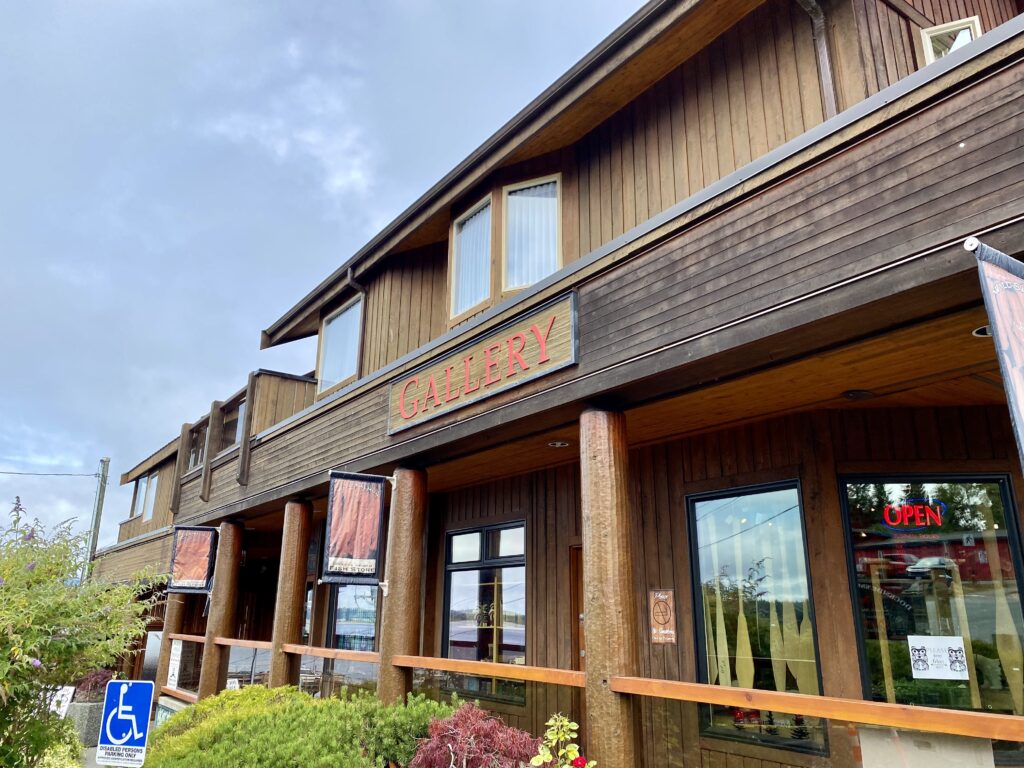
One place that does not have a laidback attitude, however, is the Wickaninnish Inn. An upscale, beach resort with a superb dining experience, it is gated location with a perpetually more stringent gate staff. Indigenous locals tend to get more of a workaround and are scrutinized if they are coming to eat compared to wandering tourists.
It is still a favourite of Tofino residents. However, the exclusive air does seems somewhat at conflict with the normally accepting atmosphere.
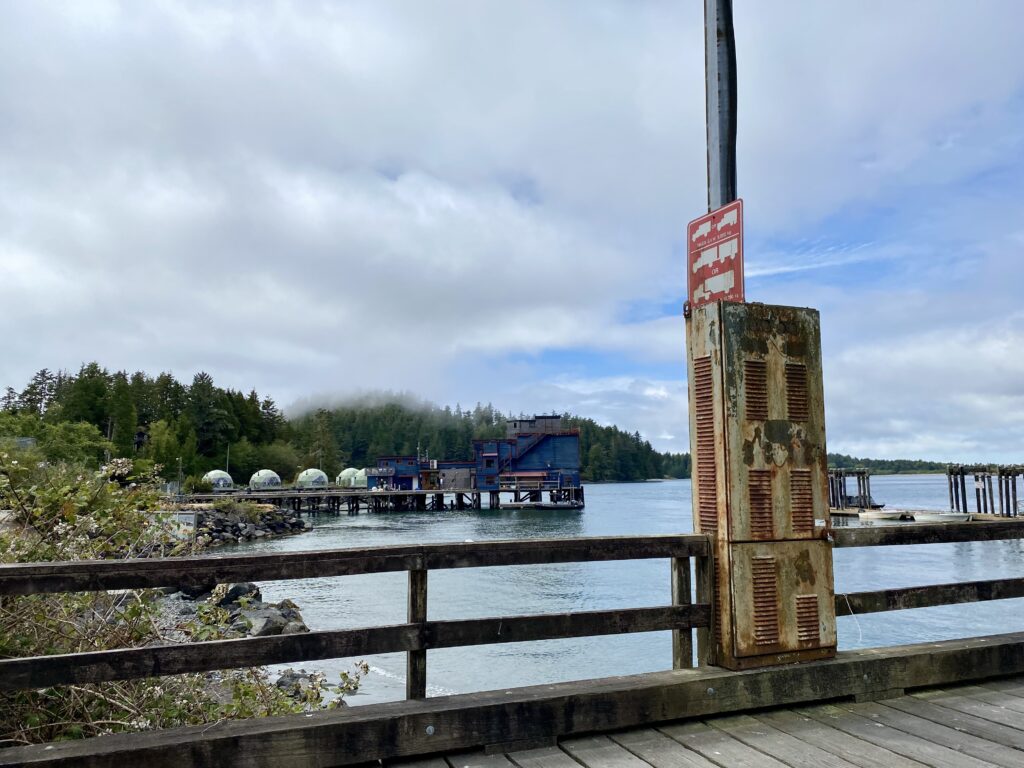
Lastly, another off the beaten track option you can choose are the glamping pods, run by Wild Pods. Close to the private residence where I was staying, these futuristic pods are waterfront domes that offer a unique experience. I would not stay there, mostly because I hate the concept of ‘glamping’. Although, the pods are conveniently located close to the Savary Island Pie Company. I do like pie.
Considerations
Like most tourist spots, Tofino shuts up shop after the tourist season. Many businesses and accommodations temporarily close for the fall and winter. This trend is common throughout most of rural and remote BC, but not always the case.
During the off seasons, Tofino is quieter, but no less beautiful with misty mornings and damp hiking trails. Travel to and from the Pacific coast inland does get a little more treacherous. Road conditions worsen in stormy weather, and the potential for landslides also increase.
However, locals frequently travel to and from Tofino during these months as well.

If you really wanted to, you could go from Nanaimo to Tofino in a full day (in maybe four hours). With road closures or delays, the route is still doable in about eight hours. However, if you rush through, you will miss the charms of the places that make this trip worth it.
Tofino has much to offer, and you can fly in if you like too. If you are making a road trip of it, the purpose is to stop and smell the cedar.
Sure, you might not always want to stop in Port Alberni for a pint, of Coombs for Khao Pad, but without those pitstops, it would not be a true drive to Tofino.
I am hoping to get back to Tofino (and Ucluelet) soon, definitely with the pooch. However, it depends when I have the free time to do it … Unless I decide to work ‘extra remotely’ compared to my usual Vancouver basecamp. We’ll see. As for posts, a summary reflection on my visit to Mexico City is forthcoming — and then 2024 is our oyster.
